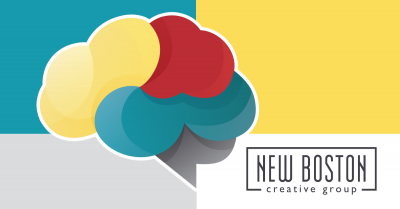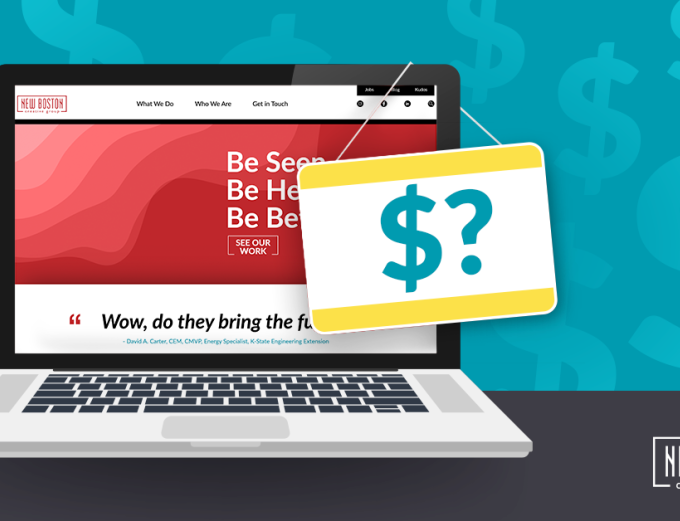The Psychology of Color
by New Boston on January 1, 2022
Have you ever heard that colors have different meanings? For example, purple means royalty, wealth and femininity. Blue means stability, trust and serenity. There are references galore that claim to break down what various colors mean. But Tammy Irvine doesn’t see color that way.
Tammy is a graphic designer at NBCG and a talented painter. Her subjects range from financial institutions and recreation companies at work, to brightly colored insects and the muted tones of velvety moths in her paintings. No matter what she’s working on, she loves playing with color.
But Tammy is quick to point out that whatever color she uses in a composition isn’t based on some predetermined meaning. It’s based on context, harmony and personal preference. We sat down with Tammy to get her take on how she works with color and other elements to help clients achieve polished branding.
Color and Context
Many people think color can evoke a mood, but it’s not the color in and of itself that does this. Color is just one piece of the puzzle. Tammy says a far more important piece is the context — how color is used in combination with symbols, as well as other art elements and overall composition.
“The psychology of color is subjective. Color doesn’t have a set meaning. It’s personal, based on whatever experience you’ve had with that color and whether you like the color or not.
Does blue mean trust? Does green? Does yellow? I often hear people say red means anger, heat or love. Then what does a red car mean? It’s how you apply a color that matters — the meaning depends on the context.
Imagine a landscape with a trail, trees and a hazy blue mist of an early morning. It’s a beautiful, serene scene. Now, remove the trail and trees, and add a graveyard. Suddenly it’s not pretty anymore. It’s creepy. That grey-blue mist is not always going to be serene if you put a different spin on it.
Green by itself doesn’t mean a dang thing. Green with a leaf could mean you’re talking about the environment. Green with a dollar sign could mean you’re talking about money. Green with an emoji could mean you’re feeling sick.
Color doesn’t always mean the same thing and it’s not going to bring on a mood all by itself. But shape, line and texture can. You get an immediate reaction to these elements. Waves and circles feel soft. Hard angles feel prickly. You have to think of color as contingent on many other factors.”
Color Harmony
Another important factor when working with color is how colors are combined. There are specific rules that dictate which colors work well together based on the mathematics of the color wheel. Together, colors can create visual harmony — or not.
“What’s amazing about nature is that all the colors are harmonious. That’s where we get the color wheel from in the first place. It’s built that way.
There are principles to follow to create a good work of art. When I paint or design, I follow the rules to determine harmonious color combinations. I’ll use a certain palette and pay attention to the value and intensity of the colors I’m using to make sure they work together.
Adobe Color is a digital tool that helps you select harmonious palettes. It picks out colors from the color wheel based on mathematical equations. It does this scientifically and I like that because my brain works that way, too. Even when I paint, I start by using the Adobe Color tool.”
Color Preferences
When working with clients, Tammy focuses on shapes and symbols to help create context and she follows the rules of color theory to create harmonious color schemes. But because color is so subjective, Tammy starts with client preference.
“Clients normally have an idea about what colors they like and don’t like. I don’t interfere with that. Whatever initial color that they like for whatever reason based on their experience, I start with that. From there, I choose a secondary color based on what scientifically complements it on the color wheel. Sometimes they’ll have two colors they like, and I’ll pick out a third to round out the brand.
From there, whether I use bright, saturated versions or dull, muted versions of colors depends on their business. I had a client that was launching an athletic company and wanted a logo that would be energetic. I chose bright colors to make it pop. But if they weren’t doing a sport, I probably would have chosen something more toned down. And sometimes a client won’t want to use a particular color because everyone else in their industry uses it.
Because shape can bring on a mood by itself, I try to get as close to the final logo as possible before applying colors. Then I usually show a client three different color combinations on that logo.
When I give a client these color schemes, if they want something different that’s not indicated by the rules of harmony, sometimes I’ll shift all the colors around the wheel just a little bit, so the colors will be harmonious and still achieve the same result.”
More About Color
When working with colors, there are other factors to consider like trends and cultural significance.
You might notice similar palettes in ads or social media graphics in a given year or even seasonally. Every year, Pantone chooses a color of the year. You’ll often see that color in paints, wallpapers, graphics and more. One color — Pantone 448C — has a dubious distinction. It was dubbed “the ugliest color in the world.” But it all goes back to personal preference. Tammy loves that color — a dull brown that can be found in everything from spectacularly patterned moths to delicate deer fawns. Remember, color trends come and go, but the rules of context and harmony last.
Culturally, certain combinations can take on added meaning of pride or patriotism. Think of college colors (purple in Manhattan, anyone?) or national colors (we’re looking at you, red, white and blue!) that would mean something to one community, but not another.
If you’re thinking your brand’s colors could use a boost, see how Tammy or our other designers can make your company shine. Give us a call — We’d love to talk more about how we can help you stand out in your industry and convey just the right tone.






